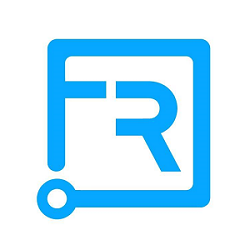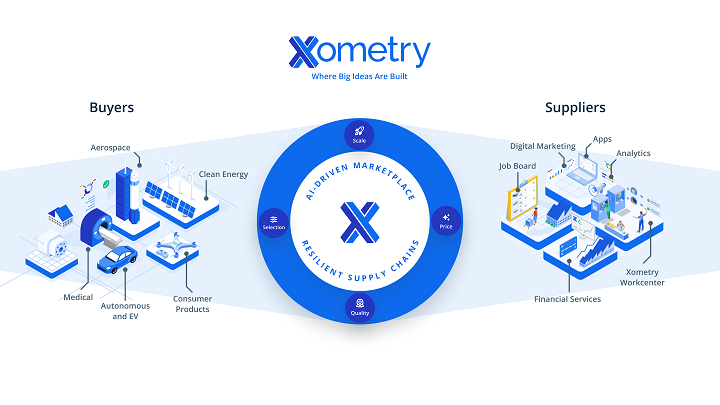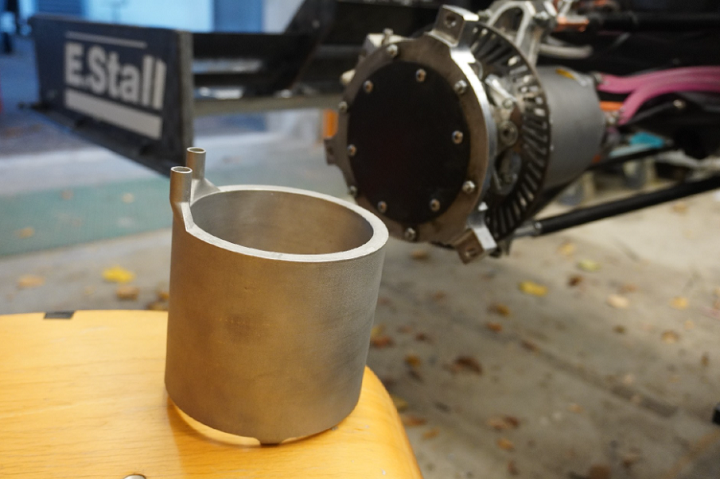In today’s 3D Printing News Briefs, starting with business, manufacturing company Fast Radius recently cut 20% of its workforce. Then, Xometry has introduced new digital sourcing tools and more. A Formula Student racing team is using Eplus3D’s metal powder bed fusion system to improve the performance of its electric race car. Finally, Smart-Ship used Hubs’ quote builder to speed up product development.
Fast Radius Cuts 20% of Workforce
Cloud manufacturing and digital supply chain company Fast Radius (FSRD) joined several other 3D printing companies in going public via a SPAC deal last year. The goal was growth, and last month the company appointed Patrick McCusker as President and Interim Chief Financial Officer and John Nanry as Chief Operating Officer, so things seemed like they were rolling right along. But then we started seeing LinkedIn posts from Fast Radius employees announcing that they had been laid off due to a cost-cutting initiative, and found that the Board of Directors had approved restructuring actions—including cutting 20% of its workforce—in order to reduce the company’s operating expenses.
The restructuring actions, which are expected to be mostly completed by the end of Q3 2022, are meant to help the company execute its strategy, which is focused on four main priorities: enhancing its software tools, user experience, and digital workflows; increasing customer acquisition efforts; building out and optimizing its marketplace and supplier network; and securing additional capital. While the cuts did include getting rid of open positions, approximately 40 people were ultimately laid off from the Fast Radius workforce. The company is also taking other operational expense management actions, such as consolidating its facilities, in an effort to save over $10 million.
Xometry Unveils New Digital Sourcing Tools, MES Supplier System
In an effort to bring buyers and suppliers even closer together, global online marketplace Xometry introduced new digital sourcing tools for enterprise buyers on Thomasnet.com, in addition to a new cloud-based manufacturing execution system (MES) for suppliers that will be open to third-party developers for building integrated applications. The Xometry Instant Quoting Engine, Job Board, and financial services features from the Xometry Marketplace have now been integrated into Thomasnet, which will enable Xometry to more quickly scale its network of active suppliers and buyers. Its new Industrial Buying Engine digitizes and condenses the old, lengthy request-for-quote process, while the new cloud-based Workcenter system makes it easy for suppliers to manage their Xometry and non-Xometry work in a centralized project management and payment solution. The API-enabled Workcenter will also be opened up to third-party developers.
“Recent global events have underscored the need for the vital role that Xometry plays in the rapid digital transformation of the manufacturing industry, from the procurement process to the shop floor. With our large and growing network of suppliers, expanding set of manufacturing capabilities and new software to integrate with our customers’ internal systems, Xometry is an enterprise-wide solution. We work across the supply chain and are deeply embedded with procurement managers, buyers and engineers on the one hand, and thousands of manufacturers on the other,” said Xometry CEO Randy Altschuler.
“We are scaling quickly to be the technology solution that drives efficiency for the $2.4 trillion manufacturing industry, and we are becoming the de facto rails through which buyers procure services and the thousands of small- and medium-sized suppliers across the country deliver it. With our new integrated Industrial Buying Engine and Workcenter offerings, we’re leveraging the strategic acquisition of Thomas with the power of our AI-driven Xometry Marketplace and Instant Quoting capabilities to deliver on our promise of advanced technology solutions benefiting buyers and suppliers. The new products align with our mission of championing manufacturing, the backbone of our economy here and abroad.”
Eplus3D Supports Formula Student Racing Team
The Formula Student Racing Team E.Stall of the Esslingen University of Applied Sciences is designing and building an electric race car to compete in the Formula Student competition, and is improving the car’s performance with 3D printing support from Chinese 3D printer manufacturer Eplus3D. The global competition is won by the team not only with the fastest car, but also with the best overall package of design, construction, performance, financial planning, and sales presentation. The E.Stall team looked at previous seasons and decided to improve the cooling system of their current car by making it more reliable; their previous polymer cooling jacket, which is meant to regulate drivetrain temperature and prevent the motor from overheating, was prone to leakage. Eplus3D’s EP-M260 Dual-Laser powder bed fusion system was used to print a cooling jacket, cooling plating for the inverters, and a steering component out of aluminum, which can easily dissipate generated heat to improve the race car’s performance.
Eplus3D’s accurate 3D printing allowed the team to create complex structures and reduce the wall thickness of the components, which also helped reduce their size and weight. Additionally, 3D printing enabled functional integration of cooling system, connectors, and mounting, which adds up to what Eplus3D calls a “failsafe design” that won’t leak. Both of the 3D printed heat exchanger parts were able to keep the motors and inverters below 65°C, which the team said is a great result, and the components can also operate more efficiently because of their low temperature. E.Stall won 4th place in Formula Student Engineering Design Competitions in the Alpe Adria region and the Czech Republic, and won first place in the Efficiency Category of an Endurance Event in Croatia—a major milestone for the team.
Hubs & Smart-Ship Developing Haptic Navigation Systems
Hubs recently published a case study about a project it completed with Dutch maritime tech startup Smart-Ship to develop haptic navigation systems and advanced training simulators for maritime vessels. Operators on these ships have a ton of information to process, usually through visual and audio input, but Smart-Ship uses haptic (tactile) feedback in levers and consoles to send signals, which makes operations safer and more efficient at high speeds and in choppy waters. The idea was born as an academic concept and transformed into a functional prototype, with Hubs serving as a partner for all of it. The original plan was to install haptic consoles and levers directly onto marine vessels, but there are a lot of regulations involved, so while the team waited for the necessary certifications, it decided to first integrate its hardware and software into maritime training simulators. The parts for the levers and simulator have to be very precise in order to give proper haptic feedback, and Hubs was able to help with this using its rapid prototyping portfolio, including 3D printing and CNC machining. FDM technology and PLA were used, but the parts that convey sensory information were made with SLS 3D printing, to ensure high tolerance and robustness. Smart-Ship used Hubs’ quote builder to efficiently iterate designs for the optimal price throughout, and earlier this year was able to successfully test its products with operators on Royal IHC’s dredging simulator; the company also installed one of its throttle levers on an inland ship for its integral locking assistance system. Having reached these milestones, Smart-Ship is now testing other levers and getting ready to sell them to shipping companies, as well as producing integrated training modules, in order to give the maritime industry a robust, safe solution. The company is still working with Hubs as it prepares to scale up its production.
“You really have to be able to assure that you can supply constant quality and everything complies with the rules and regulations. We want to show that a small company, in collaboration with a manufacturing partner like Hubs, can provide this quality,” said Smart-Ship’s CTO Jelle Tiemensma.
Subscribe to Our Email Newsletter
Stay up-to-date on all the latest news from the 3D printing industry and receive information and offers from third party vendors.
Print Services
Upload your 3D Models and get them printed quickly and efficiently.
You May Also Like
3D Printing News Briefs, July 2, 2025: Copper Alloys, Defense Manufacturing, & More
We’re starting off with metals in today’s 3D Printing News Briefs, as Farsoon has unveiled a large-scale AM solution for copper alloys, and Meltio used its wire-laser metal solution to...
3DPOD 260: John Hart on VulcanForms, MIT, Desktop Metal and More
John Hart is a Professor at MIT; he´s also the director of the Laboratory for Manufacturing and Productivity as well as the director of the Center for Advanced Production Technologies....
3D Printing News Briefs, June 28, 2025: Defense Accelerator, Surgical Models, & More
In this weekend’s 3D Printing News Briefs, 3YOURMIND was selected to join an EU Defense Accelerator, and PTC has announced model-based definition (MBD) capabilities within Onshape. Finally, a study out...
EOS in India: AM’s Rising Star
EOS is doubling down on India. With a growing base of aerospace startups, new government policies, and a massive engineering workforce, India is quickly becoming one of the most important...





































